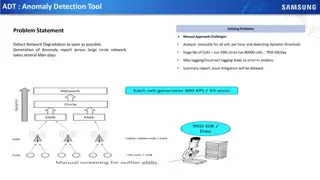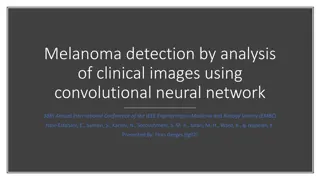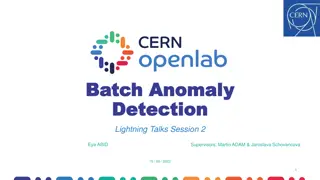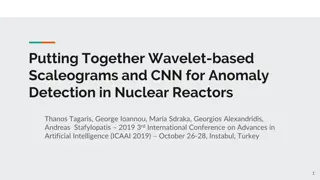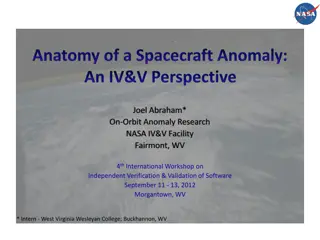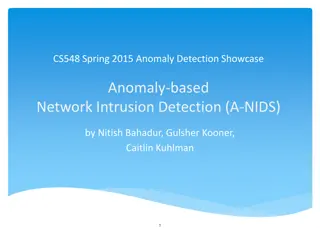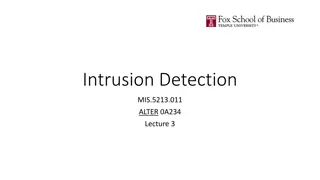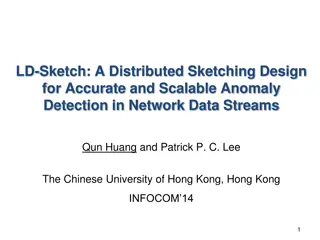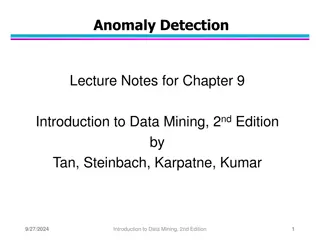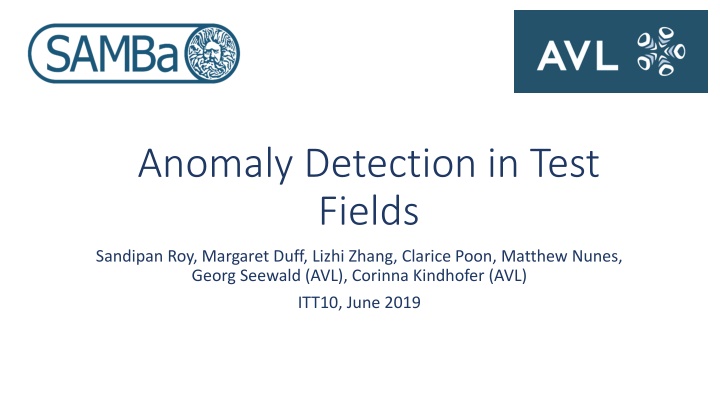
Anomaly Detection in Test Fields: Challenges and Solutions
Explore the complexities of anomaly detection in test fields and learn about innovative approaches such as inverting formulas for carbon balance, machine learning classification, and identifying changes in distribution. Find out how a simple approach using Mahalanobis distance and a unique idea of building up a distribution of good data for all sensors simultaneously can improve anomaly detection accuracy.
Download Presentation

Please find below an Image/Link to download the presentation.
The content on the website is provided AS IS for your information and personal use only. It may not be sold, licensed, or shared on other websites without obtaining consent from the author. If you encounter any issues during the download, it is possible that the publisher has removed the file from their server.
You are allowed to download the files provided on this website for personal or commercial use, subject to the condition that they are used lawfully. All files are the property of their respective owners.
The content on the website is provided AS IS for your information and personal use only. It may not be sold, licensed, or shared on other websites without obtaining consent from the author.
E N D
Presentation Transcript
Anomaly Detection in Test Fields Sandipan Roy, Margaret Duff, Lizhi Zhang, Clarice Poon, Matthew Nunes, Georg Seewald (AVL), Corinna Kindhofer (AVL) ITT10, June 2019
??2 ?? THC (????) Why is this problem difficult? Anomaly Detection in Test Fields | ITT10 | June 2019
The Plan 1. Inverting formula for carbon balance Compare the observed values of one sensor with values predicted from the other two sensors 2. Machine Learning: classification 3. Looking for changes in distribution Treat results as sampling from some unknown distribution Look for evidence of changes in distribution Anomaly Detection in Test Fields | ITT10 | June 2019
Classification Results Dataset of all unbalanced samples with faults Each set of steady state measurements labelled with Sensor 1, Sensor 2 or Both broken Some success, especially considering only individual sensors breaking. Anomaly Detection in Test Fields | ITT10 | June 2019
The Plan 1. Inverting formula for carbon balance Compare the observed values of one sensor with values predicted from the other two sensors 2. Machine Learning: classification 3. Looking for changes in distribution Treat results as sampling from some unknown distribution Look for evidence of changes in distribution Anomaly Detection in Test Fields | ITT10 | June 2019
The Idea Anomaly Detection in Test Fields | ITT10 | June 2019
Simple approach Compute mean and variances for each sensor when working and broken Compute the maximum Mahalanobis distance of a set of new sensor readings from the corresponding good and bad populations 2= ? ?? ? 1? ??, ?? ? = good,bad 2 2 If ????? Test Files File 54 - both faulty sensors detected File 64 one broken sensor correctly labelled, but a false positive on the other sensor > ???? then classify sensor to be broken Anomaly Detection in Test Fields | ITT10 | June 2019
Exciting Idea Build up a distribution of good data for all 3 sensors simultaneously For a new dataset, assume each sensor in turn is broken and recalculate data. ? ? ? ? ? ? ? ? ? A correct assumption should cause the data to become closer to the good distribution An incorrect assumption should cause the data to get further from a good distribution Anomaly Detection in Test Fields | ITT10 | June 2019
Future Direction Large number of sensors More than one sensor can fail at a time Distribution of all sensor data, calculating excluding the data from sensors in ? It is more likely that fewer sensors have failed arg min ? ??,?good+ ? ? ? ? ???=1 Learnt good distribution of all sensors Distance measure between distributions Subsets of all sensors. Anomaly Detection in Test Fields | ITT10 | June 2019

